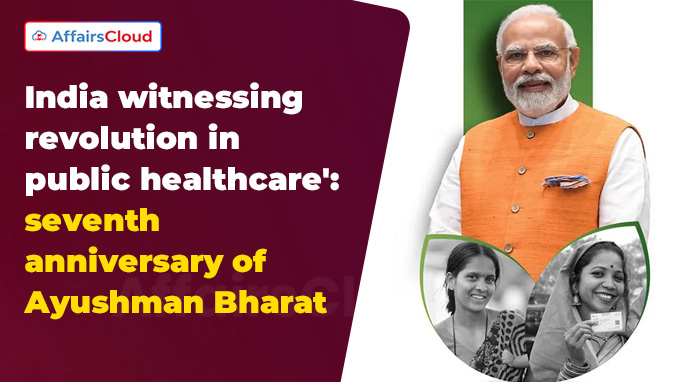On 23rd September 2025, the Prime Minister (PM) Narendra Modi marked the 7th anniversary of the Ayushman Bharat Yojana, the world’s largest health assurance scheme.
Exam Hints:
- What? 7th Anniversary of Ayushman Bharat
- Launched in: 2018
- Ministry: Ministry of Health and Family Welfare
- Components: HWC, PM-JAY
- Features: 5 lakhs coverage, public and private hospitals, cashless
- Funding: GoI fully funding
- Implementation models: Trust, Insurance, Mixed
- New development: 70 years above covered
About the scheme:
Background: The scheme previously known as the National Health Protection Scheme (NHPS) was renamed Pradhan Mantri Jan Arogya Yojana (PM-JAY), which is a key component of the broader Ayushman Bharat initiative.
- The scheme also subsumed the then existing Rashtriya Swasthya Bima Yojana (RSBY), which was launched in 2008.
The Launch: The PM launched Ayushman Bharat (AB) scheme on 23rd September, 2018 at Ranchi, Jharkhand.
Objective: It is a flagship scheme of Government of India (GoI), launched on the recommendation of the National Health Policy 2017 to achieve the vision of Universal Health Coverage (UHC).
- It was implemented by the National Health Authority (NHA) under the Ministry of Health and Family Welfare (MoHFW), in partnership with the State Health Agencies (SHAs) set up by individual states.
Components: The scheme consists of two inter-related components:
- Health and Wellness Centres (HWCs).
- Pradhan Mantri Jan Arogya Yojana (PM-JAY)
HWC: In February 2018, the GoI announced the creation of 1,50,000 HWCs by transforming existing Sub Centres and Primary Health Centres (PHC) as the base pillar of Ayushman Bharat.
- They are designed to provide comprehensive primary healthcare services, ensuring wider access, equity, and universality within communities.
- The 1st HWC was launched by the PM at Jangla, Bijapur, Chhattisgarh on 14th April 2018.
PM-JAY: This aims at providing a health cover of Rs.5 lakhs per family per year for secondary and tertiary care hospitalization across public and private empanelled hospitals in India.
- Coverage: Initially, the scheme aims to cover 10.74 crore (cr) poor and vulnerable families under AB PM-JAY, comprising the bottom 40% of India’s population.
- In January 2022, the GoI revised the beneficiary base under AB PM-JAY from 10.74 cr to 12 cr families (around 55 cr beneficiaries).
- Eligibility: The households included are based on the deprivation and occupational criteria of Socio-Economic Caste Census 2011 (SECC 2011) for rural and urban areas respectively.
- Cashless: It provides cashless access to health care services for the beneficiary at the point of service, that is, the hospital.
- Funding: The scheme is fully funded by the GoI and cost of implementation is shared between Central and State Government.
- Hospitalization: It covers up to 3 days of pre-hospitalization and 15 days post-hospitalization expenses such as diagnostics and medicines.
- Inclusivity: There is no restriction on the family size, age or gender. All pre–existing conditions are covered from day one.

Implementation Model:
The scheme can be implemented through the following three models:
- Assurance/Trust Model: Under this model, the scheme is directly implemented by the SHA without the intermediation of the insurance company. The financial risk of implementing the scheme is borne by the Government in this model. SHA essentially reimburses health care providers directly.
- Insurance Model: In this, the SHA competitively selects an insurance company through a tendering process to manage PM-JAY in the State. The SHA pays premium to the insurance company per eligible family for the policy period and insurance company, in turn, does the claims settlement and payments to the service provider.
- Mixed Model: Under this, the SHA engages both the assurance/ trust and insurance models mentioned above in various capacities with the aim of being more economic, efficient, providing flexibility and allowing convergence with the State scheme.
Key new developments:
On September 11th 2024, the GoI made the decision that all senior citizens aged 70 and above will receive health coverage, regardless of their income under this AB-JAY. Under this expansion, all senior citizens aged 70 years and above were given “Ayushman Vaya Vandana Card”, which will help them in availing healthcare benefits.
- Benefit: This expansion benefits around 4.5 crore families, including 6 crore senior citizens, by providing them with free health insurance coverage of up to Rs.5 lakh per family.
- Top-Up Coverage: This top-up of Rs.5 lakhs will be for the senior citizens and they will not have to share it with other family members under the age of 70.
- Choice of Schemes: Senior citizens who are already benefiting from other public health insurance schemes like the Central Government Health Scheme (CGHS), Ex-Servicemen Contributory Health Scheme (ECHS), or Ayushman Central Armed Police Force (CAPF) have the option to either continue with their current scheme or opt for AB PM-JAY.
- Private Insurance: Senior citizens who are covered by private health insurance policies or the Employees’ State Insurance scheme are also eligible to benefit from AB PM-JAY.
Key Achievements:
The scheme is implemented nationwide, except for West Bengal (WB).
- Admissions: As of August 2025, over 10.30 cr plus hospital admissions have been authorised, translating into more than Rs.1.48 lakh cr in cashless care and recorded out-of-pocket savings. It has also covered nearly 61 cr people.
- Coverage: It has also covered nearly 61 cr people, including one crore gig and platform workers, further widening the reach of this transformative healthcare initiative.
About the Ministry of Health and Family Welfare (MoHFW):
Union Minister – Jagat Prakash Nadda (Rajya Sabha – Gujarat)
Minister of State (MoS) – Prataprao Ganpatrao Jadhav (Buldhana, Maharashtra); Anupriya Patel – (Mirzapur, Uttar Pradesh, UP).




